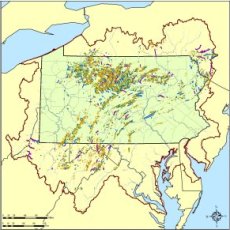 Least-Disturbed Stream Reaches
Least-Disturbed Stream Reaches
High-quality stream reaches are often used to identify aquatic habitats that are representative of the best possible stream condition. Sometimes called "reference streams," these stream reaches are frequently identified using biological data. Biological assemblages in reference streams ideally show little disturbance from human influences and demonstrate natural ecological function. A drawback to this type of analysis is that only streams that have biological samples can be considered for reference stream designation. In our study, we used landscape-level attributes of watersheds to select streams with the least amount of relative disturbance in the ACC study area. This allowed for an all-inclusive assessment of stream quality which was not limited to locations where biological data have been collected. These streams are referred to here as "Least-Disturbed Streams" (LDS).
To select LDS reaches systematically across our study region, we chose a suite of 10 landscape-level variables that serve as indicators of overall watershed quality. This method acts as a surrogate for time-consuming and costly on-the-ground field visits to individual stream locations. A key benefit of landscape-level analysis, as opposed to field visits, is that every stream reach in the study area receives the same standardized level of information.
The variables used in our study were chosen for two reasons: 1) the data were available for the entire study area and 2) the variables provide information about the degree of disturbance and the ecological integrity of stream systems. Ten variables were chosen that represent variations in point and non-point source pollution, hydrologic regime, stream connectivity and quality of riparian habitat.
For more information on LDS reaches and the data used to select them, see Chapter 9 of the ACC User's Manual.







